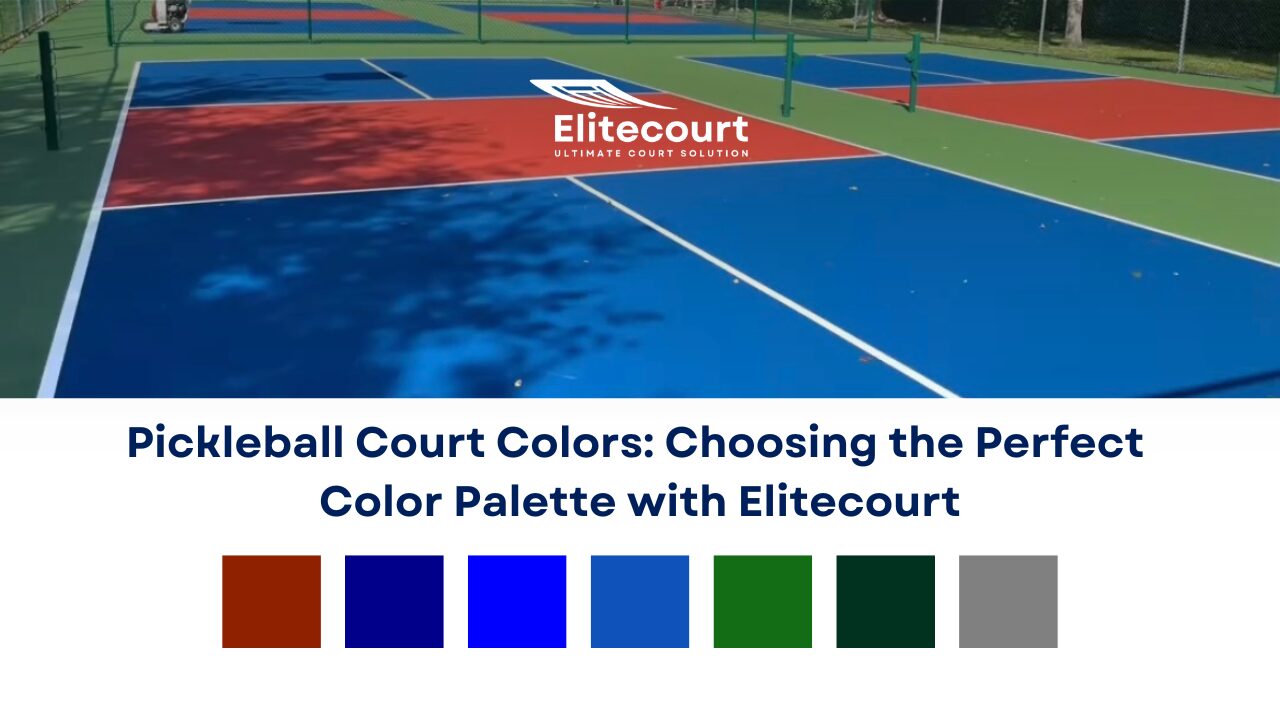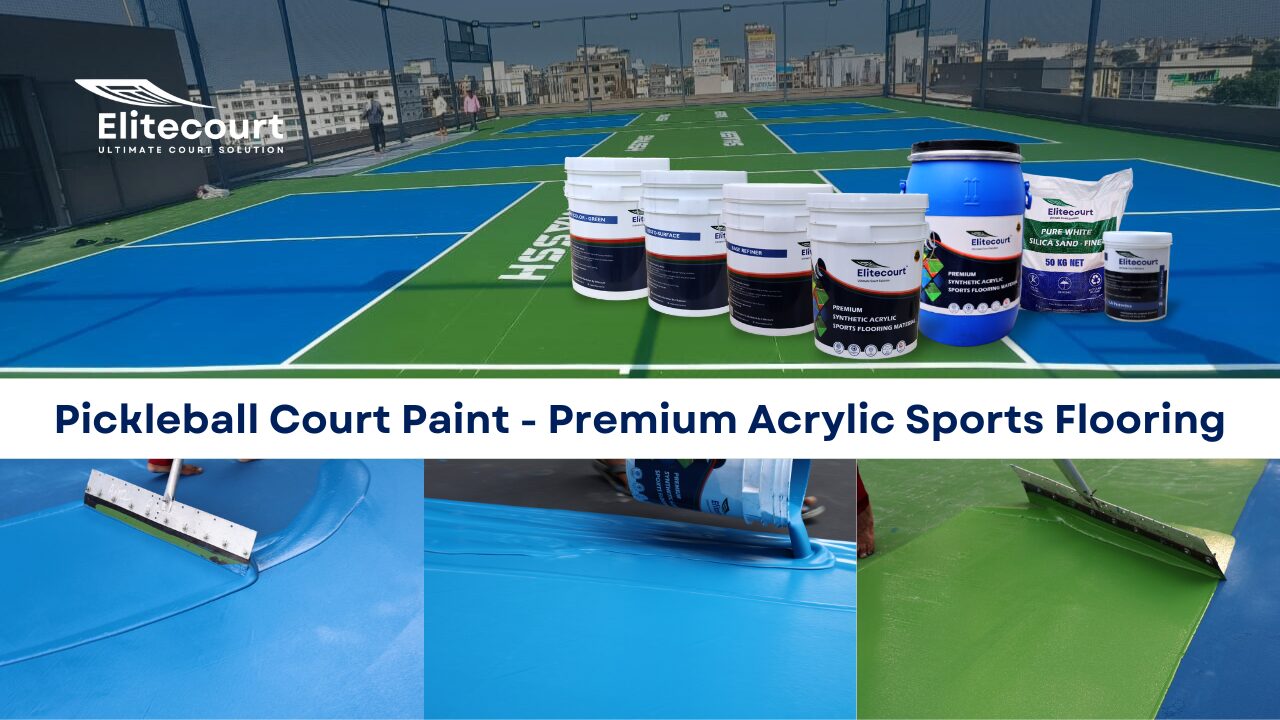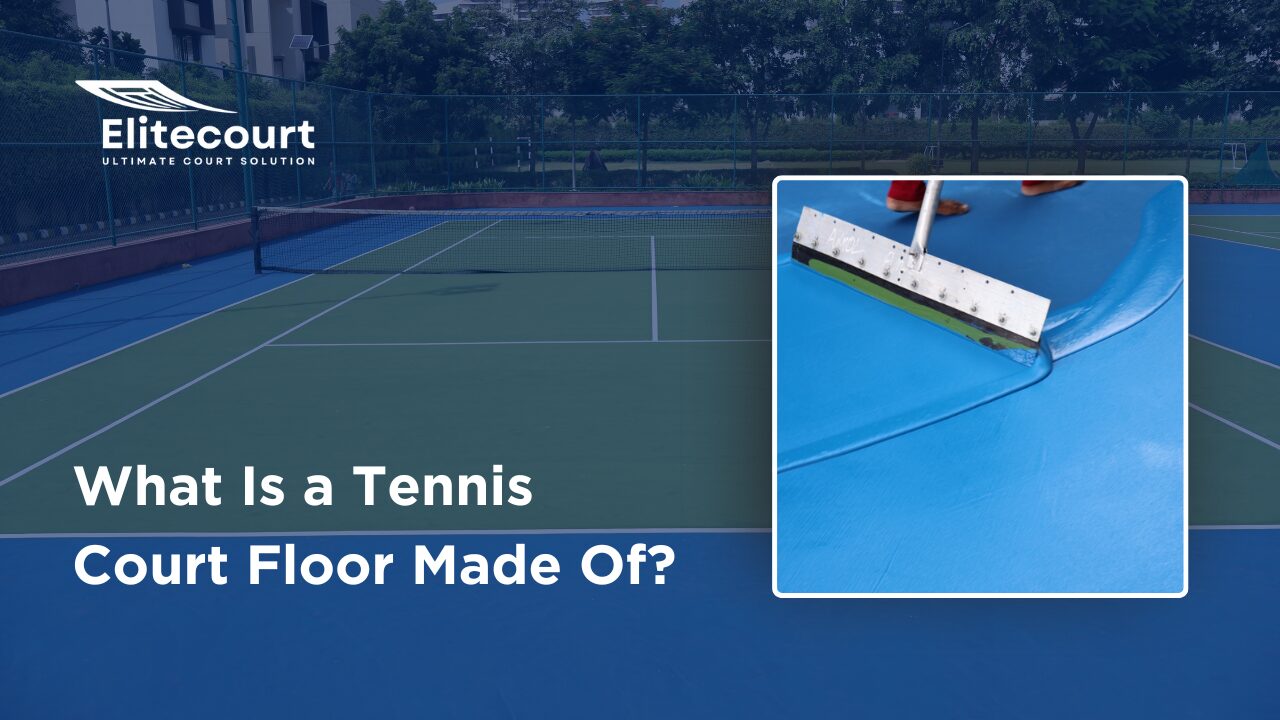What is the size of the basketball court?
At Elitecourt, we bring years of expertise in designing and manufacturing synthetic acrylic sports flooring for basketball and other courts. Trusted by schools, academies, and sports facilities across India, we combine precision with durability to deliver world-class playing experiences. Our knowledge of court dimensions, flooring standards, and performance needs ensures that your court is built to meet professional standards.
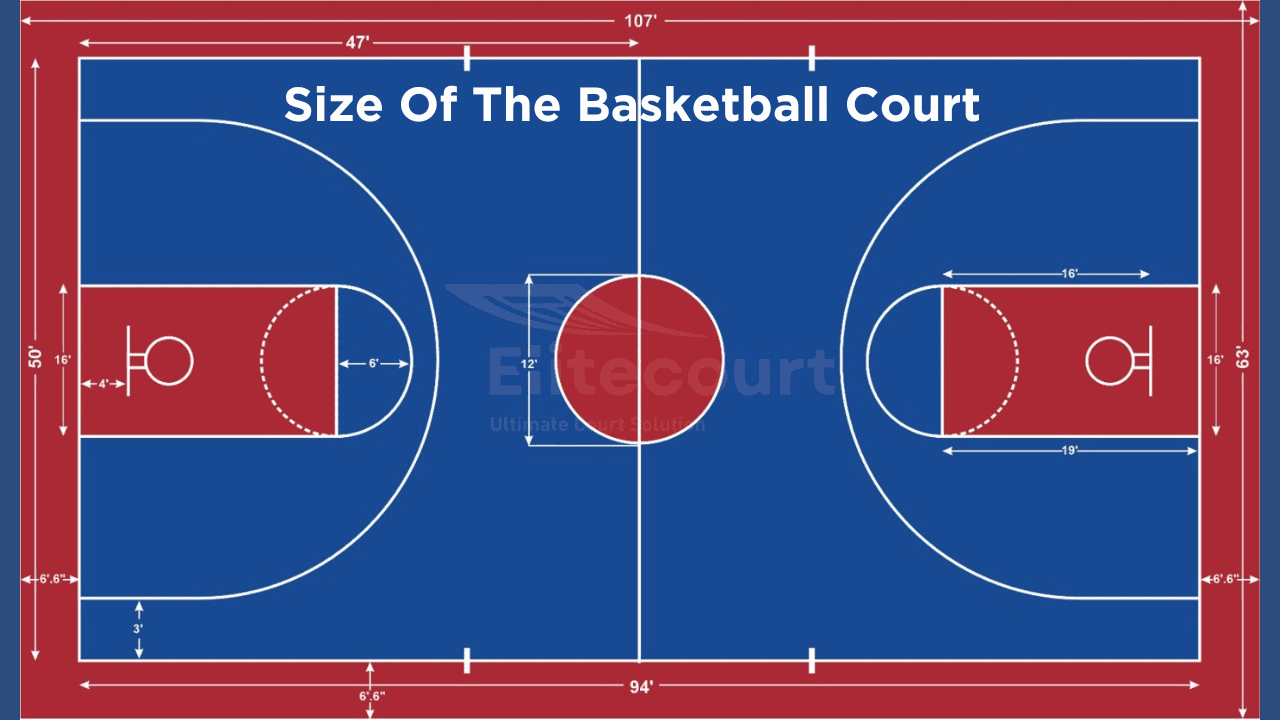
Table of Contents
Introduction – Understanding Basketball Court Dimensions
If you’ve ever asked yourself, “What is the size of the basketball court?”, you’re not alone. This is one of the most common questions coaches, athletes, and facility planners face when building or playing on a court. The short answer: a standard basketball court measures 28 meters (94 feet) in length and 15 meters (50 feet) in width. But, like many things in sports, the answer becomes more interesting when we dig deeper.
Basketball is not just a game of skill and teamwork; it is also a sport governed by strict measurements. Every inch of the court is designed with fairness, balance, and gameplay strategy in mind. From the three-point line to the free-throw lane, these markings dictate how players move, defend, and score. That’s why understanding court dimensions is as important as learning the rules of the game.
Imagine two different teams training on two different courts: one smaller than regulation, and one slightly larger. When those teams meet in competition, the adjustments required could completely alter the game’s outcome. Smaller courts mean less room for fast breaks, while larger ones demand more stamina. This highlights why standardized measurements are necessary—not only for fairness in competition but also for developing consistent skills.
At Elitecourt, we know that dimensions are not just numbers on paper. They shape the very experience of basketball. That’s why our flooring solutions are built to align with NBA, FIBA, NCAA, and school-level standards, so players can perform with confidence, no matter where they play. By the end of this guide, you’ll have a complete understanding of basketball court sizes, layouts, and their importance.
Standard Basketball Court Dimensions (NBA, FIBA, NCAA, High School)
Basketball is a global sport played everywhere from school gyms to Olympic arenas. While the essence of the game remains constant, the exact size of the court varies depending on the governing body. These small but important differences influence how the game is played—whether it’s the fast, high-scoring NBA style, the team-oriented FIBA strategy, or the development-focused school-level courts.
NBA Court Size
The NBA (National Basketball Association) is home to the world’s most recognized players and games. Its court dimensions reflect the intensity and pace of the league: 94 feet (28.65 meters) long and 50 feet (15.24 meters) wide.
Some of its standout features include:
- Three-point line: 23.75 feet (7.24 meters) from the basket at its farthest point.
- Free-throw lane (key): 16 feet (4.88 meters) wide—wider than most other courts.
- Basket height: Always 10 feet (3.05 meters).
These dimensions promote a game that thrives on speed, athleticism, and spacing. The wider key gives offensive players more room to drive, while the longer three-point line rewards elite shooting skills. Watching an NBA game, you’ll notice how these measurements create opportunities for highlight plays: fast breaks, slam dunks, and deep three-pointers.
FIBA Court Size
Globally, the International Basketball Federation (FIBA) sets the standard. Its courts measure slightly smaller: 28 meters (91.9 feet) long and 15 meters (49.2 feet) wide.
Key distinctions include:
- Three-point line: 6.75 meters (22.15 feet).
- Free-throw lane: 4.9 meters wide (about the same as NBA).
- Basket height: 10 feet, identical to the NBA.
Because the court is more compact, FIBA games often feel tighter and more tactical. There’s less room for flashy isolation plays, and more emphasis on ball movement, passing, and positioning.
NCAA (College Basketball) Court Size
In U.S. college basketball, governed by the NCAA, courts match NBA dimensions: 94 feet by 50 feet. But there are small variations that make a big difference:
- Three-point line: 22 feet, 1¾ inches (6.75 meters)—the same as FIBA.
- Key width: narrower at 12 feet, compared to NBA’s 16.
This narrower key encourages more post play and allows defenders to pack the paint. The NCAA game, as a result, is a blend of NBA pace and FIBA teamwork.
High School Basketball Court Size
High schools often use smaller courts to suit younger athletes. Standard size: 84 feet (25.6 meters) by 50 feet (15.24 meters).
Key features:
- Three-point line: 19 feet, 9 inches (6.02 meters).
- Free-throw lane: 12 feet wide.
These smaller dimensions create a more accessible environment for learning fundamentals without overwhelming developing players.
Comparison Table – Court Sizes by Governing Body
| Level/League | Length | Width | Three-Point Line | Key Width | Basket Height |
|---|---|---|---|---|---|
| NBA | 94 ft (28.65 m) | 50 ft (15.24 m) | 23.75 ft (7.24 m) | 16 ft (4.88 m) | 10 ft (3.05 m) |
| FIBA | 91.9 ft (28 m) | 49.2 ft (15 m) | 22.15 ft (6.75 m) | 16 ft (4.9 m) | 10 ft (3.05 m) |
| NCAA | 94 ft (28.65 m) | 50 ft (15.24 m) | 22.1 ft (6.75 m) | 12 ft (3.66 m) | 10 ft (3.05 m) |
| High School | 84 ft (25.6 m) | 50 ft (15.24 m) | 19.9 ft (6.02 m) | 12 ft (3.66 m) | 10 ft (3.05 m) |
This comparison makes it clear that court size is not one-size-fits-all. Each variation is intentional, supporting the level of athletes and the style of play expected.
Key Zones and Markings on a Basketball Court
A basketball court is more than just its length and width. It is a canvas of precisely measured zones and lines, each contributing to gameplay. Without these markings, basketball would lose its structure and flow.
The Free-Throw Lane (The Key/Paint Area)
Also called the key or the paint, this rectangular space sits under the basket. Players line up here during free throws, and it’s the main battleground for rebounds and post moves.
- NBA width: 16 feet.
- FIBA/High school width: narrower at 12 feet.
This difference significantly affects gameplay. A wider key creates more spacing and driving lanes (NBA), while a narrower key makes defending the basket easier (FIBA, high school).
The Three-Point Line
Introduced in the late 20th century, the three-point line transformed basketball. It rewards long-range shooting and opens up the floor.
- NBA: farthest at 23.75 feet.
- FIBA/NCAA: 22+ feet.
- High school: 19.9 feet.
The placement of this line changes how teams strategize—whether it’s stretching defenses in the NBA or focusing on passing in FIBA.
The Restricted Arc and Center Circle
- The restricted arc beneath the basket prevents defenders from drawing unfair charging fouls when too close to the hoop.
- The center circle (12 feet in diameter) is where games start with a jump ball.
Together, these markings maintain fairness and flow. At Elitecourt, when designing flooring systems, precision in line marking ensures players and referees never have to second-guess.
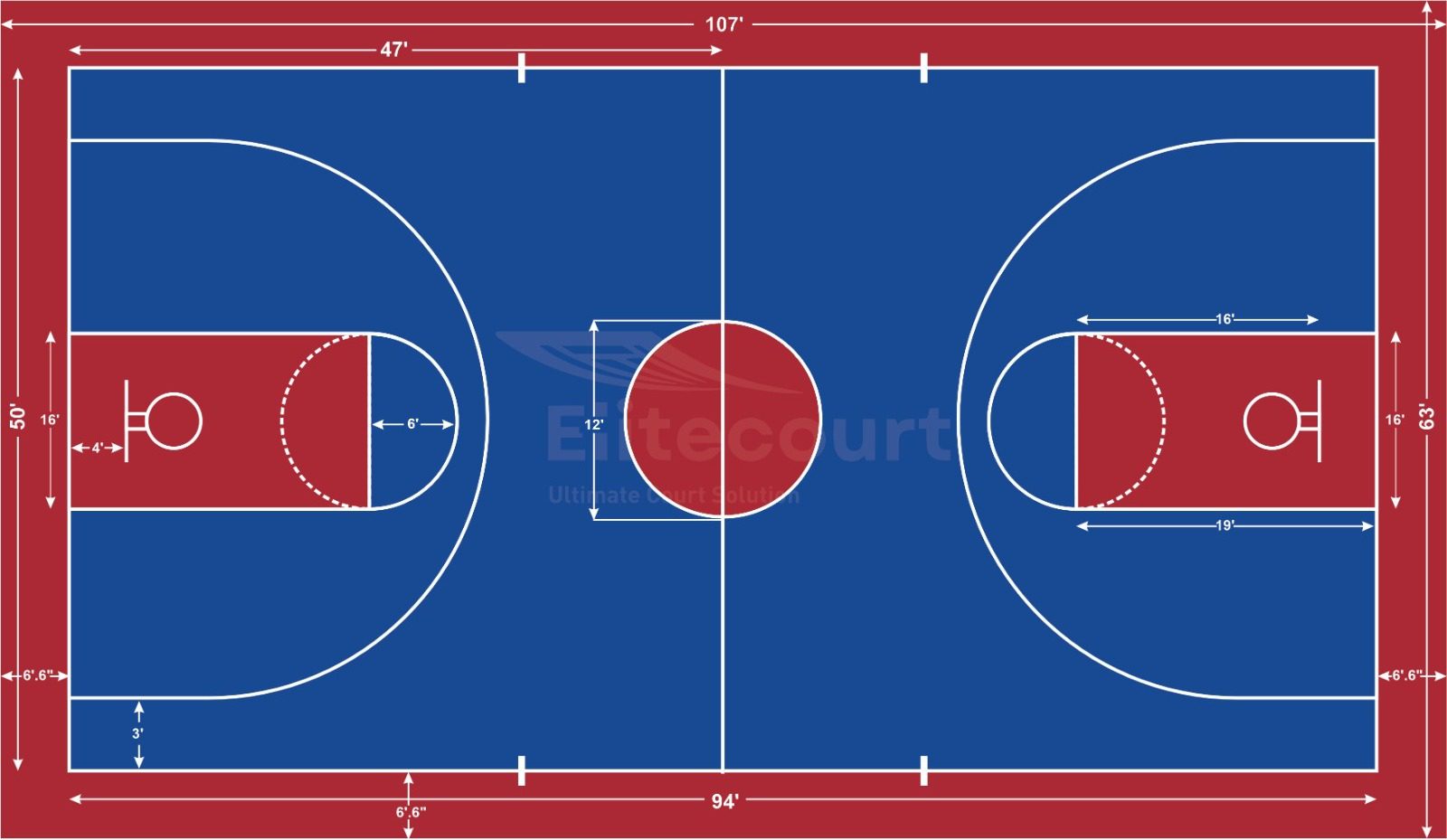
Indoor vs. Outdoor Basketball Courts
Basketball can be played both indoors and outdoors, but the court environment changes how it is designed and built.
Size Differences and Flexibility in Design
Indoor courts are almost always regulation size, especially when used for competitions. Outdoor courts, however, are more flexible: schools, communities, and residential projects often opt for half-courts or modified layouts due to space constraints. This makes basketball highly adaptable—whether in a village playground or a professional arena.
Flooring Materials (Elitecourt Synthetic Acrylic Advantages)
- Indoor: Traditionally hardwood, offering natural bounce and feel.
- Outdoor: Hardwood isn’t practical. That’s where Elitecourt’s synthetic acrylic flooring shines.
Benefits of Elitecourt acrylic:
- Durability against weather—rain, sun, and heat.
- Slip resistance for safer play.
- Consistent ball bounce, rivaling indoor courts.
- Low maintenance, making it cost-efficient long term.
This makes Elitecourt’s flooring the preferred choice for outdoor basketball courts in India, especially in schools and communities.
Maintenance Differences
- Indoor courts need polishing, climate control, and refinishing.
- Outdoor acrylic courts just need cleaning and occasional inspections.
The difference is clear: synthetic acrylic flooring combines professional-grade playability with real-world practicality.
Why Accurate Court Dimensions Are Important
Court dimensions might sound like dry numbers, but they’re the foundation of basketball. A wrongly measured court isn’t just an inconvenience—it can ruin the integrity of the game.
- Performance Impact
Court size dictates pacing. Smaller courts encourage half-court play and defense, while larger courts emphasize stamina and transition offense. Even a difference of one or two feet can alter a team’s playing style. - Player Safety
Incorrect spacing can cause unnecessary collisions. For example, a misaligned three-point arc could bring shooters too close to defenders, increasing the chance of injury. - Regulatory Compliance
For schools and academies aspiring to host tournaments, non-standard courts can disqualify them from eligibility. Governing bodies like FIBA publish precise standards to ensure global consistency. - Training Consistency
Young athletes benefit from training on regulation-sized courts. If they practice on smaller ones, the transition to professional courts can be difficult and may even hinder development.
At Elitecourt, we ensure every flooring solution aligns with recognized global standards. By maintaining strict accuracy, we help create courts where athletes can train, grow, and compete confidently.
Transform Your Sports Facility Today!
Contact us for high-quality synthetic sports flooring material and elevate your space!
How Court Size Influences Playing Style
Court size doesn’t change basketball rules, but it greatly affects gameplay. Even a few feet’ difference between an NBA and high school court can shift the pace from fast breaks to tightly contested plays.
In the NBA, a larger court and deeper three-point line favor speed, space, and athleticism. Stars like LeBron James or Giannis Antetokounmpo exploit the extra room to drive, sprint, and create high-scoring plays. Shooters spread the floor, forcing defenders to cover more ground and producing a fast, highlight-driven style.
FIBA courts, slightly smaller, emphasize teamwork and ball movement. There’s less room for individual dominance, making passing, cutting, and strategic play more important. Defense also gains an edge as recovery is quicker.
College courts blend NBA size with FIBA range, creating a hybrid style where isolation and team plays coexist. High school courts, smaller still, help younger athletes focus on fundamentals like dribbling, spacing, and shooting before moving to larger courts.
👉 Expert Tip from Elitecourt: Match court size to your athletes’ level. Too large can overwhelm beginners; too small can limit advanced players. The right size promotes skill development and smooth progression.
Materials and Flooring Standards for Basketball Courts
A basketball court isn’t just about size—it’s also about the surface beneath your feet. The flooring material directly impacts ball bounce, player safety, grip, and durability. That’s why governing bodies don’t only regulate dimensions but also recommend standards for flooring.
Traditional Hardwood Flooring
In professional indoor arenas, the gold standard is hard maple hardwood. It offers a natural bounce, smooth texture, and professional feel. However, hardwood is expensive, requires climate control, and needs frequent maintenance like polishing and refinishing.
Synthetic Acrylic Flooring – Elitecourt’s Expertise
For outdoor and multipurpose courts, hardwood isn’t practical. This is where Elitecourt’s synthetic acrylic flooring comes in. Designed to withstand India’s diverse weather conditions, it combines performance with longevity.
Benefits of synthetic acrylic flooring include:
- Consistent ball response: Provides a reliable bounce, critical for practice and competitive play.
- Slip resistance: Reduces the risk of injuries, even during monsoon humidity.
- Weather durability: Unlike wood, it doesn’t warp, crack, or degrade under rain and heat.
- Low maintenance: Requires only periodic cleaning, unlike hardwood that needs refinishing.
- Customization: Courts can be designed with vibrant colors and accurate markings for visibility.
Why Flooring Standards Matter
The flooring doesn’t just support the players—it shapes the entire game. For instance, if the surface is too slippery, players can’t cut or jump effectively. If it’s too hard, it increases the risk of injuries. By following global flooring standards, Elitecourt ensures that athletes play on a surface that’s safe, reliable, and performance-oriented.
👉 Elitecourt Insight: Many schools and academies make the mistake of prioritizing size while ignoring flooring quality. But a court that meets dimensions yet lacks proper flooring will not deliver the full experience. That’s why size and surface should always go hand-in-hand.
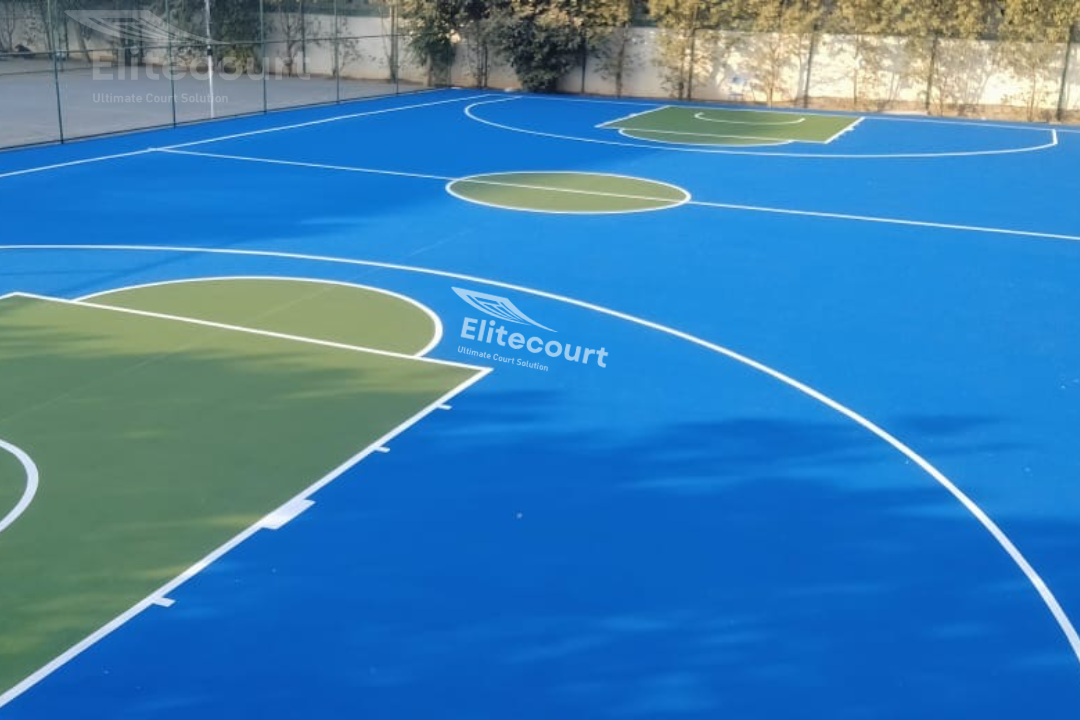
Transform Your Sports Facility Today!
Contact us for high-quality synthetic sports flooring material and elevate your space!
Outdoor Basketball Court Design Considerations
Building an outdoor basketball court comes with unique challenges and opportunities. While indoor courts enjoy controlled conditions, outdoor courts must balance performance, durability, and environmental factors.
Space Planning
Not every community or school has the space for a full-sized NBA or FIBA court. That’s why many opt for half-court designs, especially for recreational use. Half-courts require less space and cost while still allowing players to practice dribbling, shooting, and defense. Elitecourt manufactures flooring systems adaptable for both full and half-court builds, ensuring no compromise in performance.
Environmental Factors
- Sunlight & UV exposure: Outdoor courts face direct sunlight, which can fade and weaken surfaces over time. Elitecourt acrylic flooring is UV-resistant, retaining its finish and strength.
- Rain & drainage: Poor drainage can create puddles, leading to slippage and surface damage. Proper slope design and water-resistant materials ensure year-round usability.
- Temperature changes: In India’s diverse climate, from extreme heat to heavy monsoons, Elitecourt flooring maintains structural stability.
Customization and Community Use
Outdoor courts often serve multiple purposes: school events, community gatherings, or even as multi-sport surfaces. Acrylic flooring can be designed with multi-colored markings to accommodate volleyball, badminton, or tennis alongside basketball.
👉 Pro Tip: When designing outdoor courts, don’t just focus on dimensions—factor in the surrounding space for safety zones, seating, and lighting. This enhances usability and makes the court a true community hub.
Basketball Court Accessories and Add-ons
While the court’s dimensions and flooring form the foundation, accessories bring it to life. These elements don’t alter the size of the court but play a huge role in enhancing the overall experience.
Hoops and Backboards
- Standard height: 10 feet from the surface.
- Backboards can be tempered glass for professional play or acrylic/polycarbonate for outdoor use.
- Proper hoop installation ensures consistency in rebounds and shot accuracy.
Court Lighting
For outdoor facilities, lighting extends playtime beyond daylight hours. Properly installed LED floodlights reduce shadows and provide consistent visibility without blinding players.
Seating and Sidelines
Even at school or community levels, bleachers or benches improve the viewing experience. Enough sideline space also ensures player safety by preventing collisions with spectators.
Line Markings and Color Zones
Markings must be accurate and high-contrast for referees and players. Elitecourt provides UV-stable, non-fading line paints that remain visible in all weather conditions.
These add-ons don’t change the official size of the basketball court, but they complete the environment, transforming a playing surface into a professional-quality facility.
Common Mistakes in Basketball Court Planning
Even with the right intentions, many organizations and schools make mistakes when designing basketball courts. These mistakes often stem from overlooking small details that end up having big consequences.
Incorrect Dimensions
Sometimes courts are built without strict adherence to FIBA, NBA, or high school standards. Even being off by a few inches can make a court unsuitable for competitions. Precision is key.
Overlooking Flooring Quality
A shiny court may look appealing, but if it lacks grip or durability, it’s unsafe. Hardwood without climate control, or asphalt without protective coating, quickly deteriorates. Elitecourt’s synthetic acrylic avoids these pitfalls.
Poor Drainage in Outdoor Courts
Without proper drainage, rainwater collects and damages surfaces. This not only shortens the lifespan of the court but also makes it dangerous to play on.
Ignoring Safety Zones
A regulation basketball court includes space beyond the sidelines for safety. Many planners ignore this, squeezing courts into smaller spaces, which increases the risk of collisions.
Using Inaccurate Line Markings
Court markings are as important as the court itself. Misaligned three-point arcs or incorrectly sized keys create confusion and frustration during games.
👉 Elitecourt Reminder: A basketball court is an investment in sport and community. Cutting corners on dimensions, flooring, or design might save time initially, but it leads to long-term problems. Precision, quality materials, and expert planning are essential for lasting results.
Can You Play Basketball on Smaller Courts?
Not every game of basketball takes place on a full-size NBA or FIBA court. In fact, many people—especially in schools, gyms, and residential complexes—play on smaller or half-sized courts. But does that change the game? The short answer: yes, but in exciting ways.
The Benefits of Smaller Courts
- Accessibility: A smaller court makes basketball more approachable, especially for beginners or younger athletes. They don’t get overwhelmed by the scale, and the shorter distances help build confidence in dribbling and shooting.
- Skill Development: With less room, players are forced to improve ball handling, quick decision-making, and close-contact defense. It’s a training ground for sharper fundamentals.
- Faster Games: Half-court basketball is often more intense because possessions change quickly. Players constantly switch between offense and defense, making it a great cardio workout.
- Community-Friendly: Smaller courts fit in schools, playgrounds, and housing societies where space is limited, making basketball accessible to more people.
Adjusting the Rules for Smaller Courts
- Half-Court Games: Typically played with 3-on-3 or 4-on-4 formats, focusing on offense and defense within a single basket.
- Shortened Shot Clock: Many half-court formats use shorter possessions, increasing pace.
- Modified Three-Point Line: Depending on space, some half-courts shorten or eliminate the arc entirely.
Why Smaller Courts Still Matter
Playing on smaller courts doesn’t take away from basketball’s essence—it enhances it. Even professional players use smaller spaces for practice drills. They help build endurance, spacing awareness, and adaptability.
👉 Elitecourt Tip: When planning a smaller basketball court, focus on proportionate markings. Even if the court isn’t regulation size, accurate key, free-throw, and three-point markings create a more authentic experience for players.
Transform Your Sports Facility Today!
Contact us for high-quality synthetic sports flooring material and elevate your space!
Basketball Court Size Around the World
Basketball may have been invented in the U.S., but it has since spread globally, with variations in court size, style of play, and cultural influence.
United States (NBA & NCAA)
The U.S. courts are the largest in the world, setting the benchmark at 94 x 50 feet. This extra size reflects the American style of play—fast, physical, and entertainment-driven. College basketball mirrors NBA court dimensions, ensuring athletes seamlessly transition to the professional level.
International (FIBA)
Outside the U.S., FIBA courts dominate. Slightly smaller at 28 x 15 meters, they encourage tactical play, teamwork, and efficiency. The difference may be subtle, but international fans notice the more deliberate pacing, greater ball movement, and structured offensive sets.
Asia
In many Asian countries, including India, basketball is growing rapidly, but space constraints mean that schools and communities often rely on half-courts or modified dimensions. This doesn’t diminish the sport—it makes it more flexible and accessible.
Europe
Europe follows FIBA standards strictly, but the style of play there also emphasizes teamwork, passing, and fundamentals. The slightly smaller court complements this philosophy, ensuring games are competitive and efficient.
Why Variations Exist
The differences in size reflect cultural priorities: the U.S. values spectacle and athleticism, while international basketball leans on strategy and fundamentals. Yet at its core, the game remains the same: two hoops, one ball, and endless excitement.
👉 Elitecourt Perspective: In India, where land availability can be a challenge, understanding these global variations helps institutions design courts that balance space efficiency with professional standards.
Choosing the Right Court Size for Your Needs
When building a basketball court, one of the most critical decisions is choosing the right size. Not every facility needs a full NBA-standard court. The choice depends on who will use it, where it’s located, and what purpose it serves.
Schools and Educational Institutions
For schools, the priority is development. A high school-sized court (84 x 50 feet) is often sufficient. It’s large enough for proper gameplay but manageable for younger players. Many schools also prefer half-courts for recreational use.
Sports Academies
Training academies benefit from full NBA or FIBA courts, depending on whether they prepare athletes for domestic or international competitions. Using regulation-sized courts ensures players are ready for higher-level play.
Community Centers and Residential Complexes
Here, space is usually limited. A half-court or slightly reduced full-court works well for recreational games. The focus is on accessibility and fun, not strict competition.
Professional Arenas
For competitive tournaments, only full-sized NBA or FIBA courts are acceptable. Accuracy in dimensions and markings is non-negotiable, as these venues represent the highest level of the sport.
👉 Elitecourt Advice: Think long-term. A school that invests in regulation courts today can host tournaments tomorrow. A community that installs durable flooring now saves years of maintenance costs later. The right court size isn’t just about present needs—it’s about future opportunities.
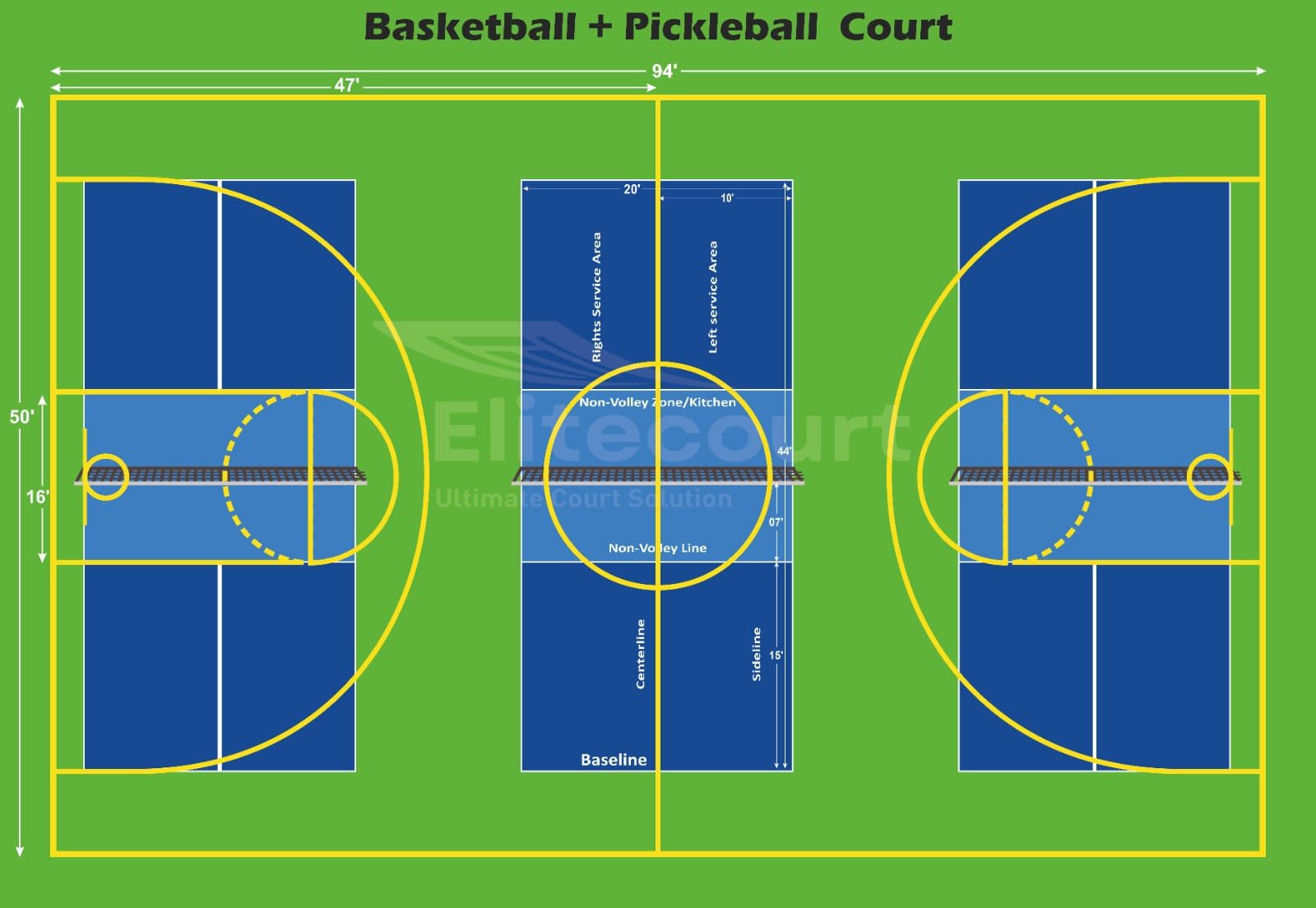
Expert Tips from Elitecourt for Court Planning
At Elitecourt, we’ve worked with countless institutions across India, and we know that planning a basketball court involves more than just drawing lines. Here are our top expert tips:
- Start with Standards: Always reference FIBA or NBA regulations for dimensions, even if you scale down. Accuracy ensures consistency.
- Prioritize Flooring: Don’t compromise on the surface. Elitecourt’s synthetic acrylic flooring offers the best balance of performance and durability, especially outdoors.
- Plan Safety Zones: Leave at least a few feet of clearance beyond baselines and sidelines. This prevents collisions and accidents.
- Think About Multipurpose Use: Many schools and communities need courts for more than basketball. With Elitecourt’s acrylic flooring, you can include markings for volleyball or tennis without reducing basketball quality.
- Choose Visible Markings: Use high-contrast, weather-resistant paints. Clear lines reduce disputes and make games smoother.
- Factor in Environment: For outdoor courts, plan for drainage, shade, and lighting. Elitecourt flooring holds up in all conditions, but surrounding infrastructure enhances usability.
- Consider Player Development: If your facility trains young players, start with high school dimensions. For elite training, go with NBA or FIBA sizes.
👉 Elitecourt Key Reminder: The best basketball courts are those that combine accurate size, quality flooring, and smart design choices. This creates a facility that lasts for years and supports athletes at every level.
Transform Your Sports Facility Today!
Contact us for high-quality synthetic sports flooring material and elevate your space!
Conclusion
So, what is the size of the basketball court? The answer depends on where you play:
- NBA/NCAA: 94 x 50 feet.
- FIBA: 28 x 15 meters.
- High school: 84 x 50 feet.
Beyond numbers, though, basketball courts are about precision, performance, and purpose. The size sets the stage, the markings define the rules, and the flooring ensures safety and enjoyment.
At Elitecourt, we believe a basketball court should be more than a playing surface—it should be a space where athletes learn, grow, and thrive. Whether you’re planning a school court, a professional facility, or a community half-court, getting the size and surface right is the key to creating lasting impact.
Basketball’s magic lies in its simplicity: one ball, two hoops, endless possibilities. But behind that simplicity is a foundation of carefully measured dimensions, expertly crafted flooring, and thoughtful planning. That’s where Elitecourt delivers excellence—helping India play the game on courts that meet international standards.
FAQs
An NBA court measures 94 feet long and 50 feet wide. The basket is set at 10 feet, and the three-point line is 23.75 feet from the hoop at its farthest point. These dimensions create the fast-paced, high-energy style the NBA is known for.
A FIBA court is slightly smaller at 28 meters by 15 meters. The three-point line is only 6.75 meters away, compared to the NBA’s 7.24 meters. This smaller layout encourages team play, passing, and strategy over individual isolation plays.
High school courts measure 84 feet by 50 feet, making them easier for younger players to handle. The shorter three-point line and narrower key help athletes develop skills gradually before advancing to college or professional-sized courts.
Yes, basketball is flexible. Many communities use half-courts or custom sizes when space is limited. These are great for practice, casual games, and formats like 3×3 basketball, which is now recognized worldwide.
Court markings define gameplay—like where three-pointers start or where free throws are taken. Without correct markings, games become confusing and unfair. Even on smaller courts, accurate, visible lines are essential for a professional playing experience.
Final Thoughts
Understanding the size of a basketball court goes far beyond numbers on paper. It’s about knowing how those dimensions shape the game, from NBA showdowns to schoolyard matches. Whether it’s a full-sized professional court or a half-court in your community, the principles remain the same: precision, safety, and performance.
At Elitecourt, we pride ourselves on manufacturing synthetic acrylic flooring that matches these principles. Our courts are not only durable and weather-resistant but also built with attention to detail—from dimensions to markings—so players can experience basketball the way it was meant to be played.
Basketball thrives because it’s adaptable. You can play it anywhere, from a grand arena to a neighborhood playground. But the experience is elevated when the court is built with care and accuracy. That’s where Elitecourt comes in—helping schools, communities, and institutions create world-class courts in India that inspire the next generation of athletes.


